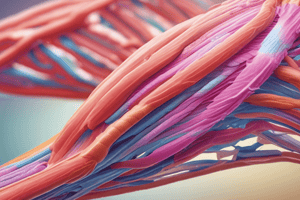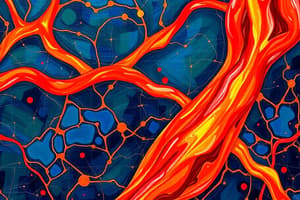Podcast
Questions and Answers
Which pathway is primarily responsible for ATP production during short bursts of intense exercise?
Which pathway is primarily responsible for ATP production during short bursts of intense exercise?
- Oxidative phosphorylation
- Krebs cycle
- Anaerobic glycolysis
- Creatine phosphate transfer (correct)
What is the main advantage of oxidative phosphorylation compared to anaerobic glycolysis?
What is the main advantage of oxidative phosphorylation compared to anaerobic glycolysis?
- It produces ATP without oxygen.
- It generates a greater number of ATP molecules per glucose molecule. (correct)
- It occurs entirely within the cytoplasm.
- It requires less time to commence ATP production.
Which of the following correctly describes muscle fiber types in terms of their energy use?
Which of the following correctly describes muscle fiber types in terms of their energy use?
- Type I fibers primarily use glycolysis for energy.
- Type I fibers are adapted for aerobic activity and rely on oxidative phosphorylation. (correct)
- Type II fibers are low in myoglobin content and rely mainly on aerobic metabolism.
- Type II fibers have high endurance and rely on oxidative phosphorylation.
What occurs during muscle hypertrophy?
What occurs during muscle hypertrophy?
How does the motor control system adapt during prolonged exercise?
How does the motor control system adapt during prolonged exercise?
What is the primary difference between oxidative fibers and glycolytic fibers?
What is the primary difference between oxidative fibers and glycolytic fibers?
What triggers muscle hypertrophy?
What triggers muscle hypertrophy?
Which of the following is true regarding skeletal muscle tone?
Which of the following is true regarding skeletal muscle tone?
What type of muscle fiber conversion is possible?
What type of muscle fiber conversion is possible?
What distinguishes voluntary movements from reflexes?
What distinguishes voluntary movements from reflexes?
What occurs as a result of denervation atrophy?
What occurs as a result of denervation atrophy?
Which motor activity is characterized by repetitive patterns?
Which motor activity is characterized by repetitive patterns?
During isotonic contractions, what remains constant while the muscle changes length?
During isotonic contractions, what remains constant while the muscle changes length?
Which type of muscle contraction involves a muscle developing tension without changing length?
Which type of muscle contraction involves a muscle developing tension without changing length?
What characterizes concentric contractions regarding load and velocity?
What characterizes concentric contractions regarding load and velocity?
Which statement accurately describes eccentric contractions?
Which statement accurately describes eccentric contractions?
In the context of muscle metabolism, glycolysis primarily occurs in which cellular compartment?
In the context of muscle metabolism, glycolysis primarily occurs in which cellular compartment?
Which of the following best describes oxidative phosphorylation?
Which of the following best describes oxidative phosphorylation?
Which type of muscle fiber is primarily engaged in endurance activities?
Which type of muscle fiber is primarily engaged in endurance activities?
What is the primary characteristic of muscle hypertrophy?
What is the primary characteristic of muscle hypertrophy?
What primarily causes muscle atrophy?
What primarily causes muscle atrophy?
Which motor control mechanism primarily regulates voluntary movements?
Which motor control mechanism primarily regulates voluntary movements?
Flashcards are hidden until you start studying
Study Notes
Muscle Fiber Types
- Fast twitch fibers are defined by higher ATP-splitting activity, also known as myosin ATPase activity.
- Different muscle fibers have different ATP-synthesizing abilities.
- Oxidative fibers produce more ATP through oxidative phosphorylation than glycolytic fibers which makes them more resistant to fatigue.
- The genetic endowment of muscle fibers varies, not only among individuals but also within muscles of one individual.
- It is possible to induce changes in muscle fibers, specifically in their oxidative capacities and diameters.
Muscle Metabolism and Fiber Types
- The body has 3 primary pathways for synthesizing ATP during muscle contraction.
- Transferring a high-energy phosphate from creatine phosphate to ADP
- Oxidative phosphorylation
- Anaerobic glycolysis
- Creatine phosphate is the first energy store used at the onset of muscle activity. It provides energy to ADP in order to form ATP.
Control of Motor Movement
- A nervous system command to contract a motor neuron, triggers a contraction of all skeletal muscle fibers within its motor unit.
- Human motor activity is typically categorized as reflex, voluntary, or rhythmic.
- Reflexes are automatic responses to stimuli that do not require conscious effort.
Withdrawal Reflex
- An example of a reflex. A painful stimulus causes a withdrawal of a limb.
Crossed Extensor Reflex
- A postural reflex that stabilizes the body when a withdrawal reflex occurs.
- It ensures that the opposite limb is in a position to bear weight.
Muscle Tone
- Muscle tone is the constant, involuntary, low-level tension within a muscle.
- This helps to maintain postural stability.
- There are 2 contributing factors to muscle tone:
- Elasticity of the muscle
- Muscle physiology
Types of Contraction
- Isotonic: The muscle changes length while the load remains constant. It's like when you lift an object.
- Isokinetic: The muscle changes length while the velocity of shortening remains constant. This is often found in exercise machines.
- Isometric: The muscle contracts but does not change length. This occurs when you hold a weight in a fixed position or maintain posture.
Concentric and Eccentric Contractions
- Concentric: The muscle shortens, and the higher the load, the lower the velocity at which the muscle fiber shortens.
- Eccentric: The muscle lengthens. This is like lowering a book to place it on a desk. There is a direct relationship between eccentric contraction velocity and load.
Lever Systems: Muscles, Bones, and Joints
- Bones act as levers; joints act as fulcrums (pivot points).
- Muscle insertion points are often situated farther from the joint, resulting in a mechanical disadvantage. For example, the bicep muscle must exert a force 7 times greater than the load to lift a weight.
Motor Units
- A motor unit consists of one motor neuron and all the muscle fibers that it innervates.
Twitch Summation
- When a muscle fiber receives a single action potential (AP), it produces a twitch.
- Two twitches from two APs can sum together to produce greater tension than one.
- This happens because an AP is much shorter than the duration of a twitch.
Twitch Summation and Tetanus
- As the frequency of APs increases, the amount of tension produced by the muscle fiber increases until it reaches a maximum (tetanus).
Length-Tension Relationship
- The optimal muscle length for generating the maximum amount of tension is Io.
- This is the length where the overlap between myosin cross-bridges and actin's binding sites is optimal.
Studying That Suits You
Use AI to generate personalized quizzes and flashcards to suit your learning preferences.




